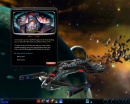|
|
 |
TREKCORE >
GAMING >
ST ONLINE >
DESIGNER DIARY > Expanding on a Concept
PUBLISHED: Dec 4, 2007
AUTHOR:
Mike Stemmle
This was originally published on the official Star
Trek Online website. Entry 5.0
- "Interactions in Action"
Stardate 61390.2 (December
4th, 2007)
Hola, STO fans, and welcome back to the DevLog!
There's something darned cool lurking in this entry, so let's skip the
endearingly goofy banter and get right to it...
Over the past few DevLogs we've primarily focused on a sampling of the
low-level processes of STO development, taking a peek at terrain
generation, object design, and version testing, among other things.
Today we'd like to seriously shift gears, and start revealing a little
bit about the actual game systems themselves. We'll start with a
deceptively simple game mechanic that's deucedly difficult to nail down:
the Interaction System.
What's the Interaction System you ask? In a nutshell, the Interaction
System controls every non-combat, player-to-NPC interaction in the game.
If you want to talk to a Ferengi shopkeeper, it goes through the
Interaction System. Need to get some additional phaser training at the
local Starfleet Academy? That's the Interaction System. Want to beam
down to a planet? Interaction System. Responding to a distress call from
a crippled starship? That's the Interaction System, too. In fact, when
one is done tallying up the mission givers, trainers, vendors, Transwarp
Terminal operators, Dahar Masters, helpful cadets and informative
colonists, you'll find that there are just about as many peaceful
interactions in Star Trek Online as the phasers-and-bat'leths variety.
Put plainly, the Interaction System is the glue that holds all the other
systems of STO together, transforming a bunch of disconnected (though
spectacularly well designed and balanced) phaser fights into an actual
game, so it's vitally important that we get it "just right."
As we design, implement, and refine our Interaction System, we're trying
to keep a few basic goals in mind:
- Keep it Simple - The less clicks and
extraneous buttons the better.
- Keep it Intuitive - The best Interaction
System is one the player can figure out without any instruction.
- Keep it Consistent - No matter where the
player is (ground, space, another dimension) or what kind of
interaction he's engaged in (dialogue, buying, training, obtaining
missions, etc.) the widgets of the Interaction System's interface
should behave in a consistent manner.
- Keep it Trek - A blanket goal of STO, but
one that bears repeating.
Keep if Fun - You'd be surprised how often this gets forgotten.
So, what can you interact with in STO? A better
question might be: what CAN'T you interact with?
When playing on the "ground" (the surface of a
planet, the promenade of a space station, or the interior of an
"abandoned" Borg cube, etc.), players will use the Interaction System to
chat with terrified aliens, order cups of Earl Grey from station
replicators, launch games of chance from charming Dabo girls, and get
missions from Starfleet superiors, among scores of other activities. All
of these interactions, from the mundane to the sublime, will be launched
by the most casual of mechanisms ("Keep it Simple"): a single
right-click of the mouse on a neutral or friendly NPC.
While flying through space in a starship, players will use the
Interaction System in exactly the same way ("Keep it Consistent")... but
the NPCs the player will interact with will reflect more of the awesome
diversity of the Star Trek universe. In space, players can respond to
hails from officials on distant planets, or get orders from the
commanders of besieged space stations, or do business with the owners of
untrustworthy Orion shipyards, simply by right-clicking on those
planets, space stations, or shipyards in exactly the same manner as if
they were on the ground. In fact, the Interaction System is often the
key to the player's ability to transition between space and ground, as
ably illustrated by our VERY FIRST RELEASED IN-GAME SCREEN SHOT:

Unfortunately, while the Interaction System of
Star Trek Online may be nigh-infinitely expandable, our blog space is
not, which is why it's time to bring this DevLog entry to a close.
Please stay tuned for the next DevLog, which will reveal even more
interesting tidbits about the development, systems, and content of Star
Trek Online.
On behalf of everyone here at STO, thanks for the continued enthusiasm
for Star Trek Online,
Mike Stemmle, Story Hologram
PS Big thanks to Greg, Steve, Daron, and Sean for helping to get this
DevLog together.
|


